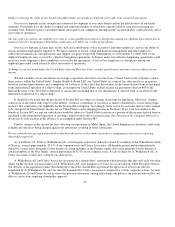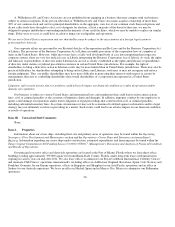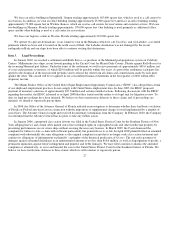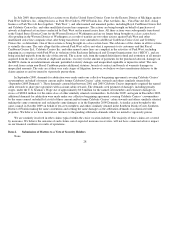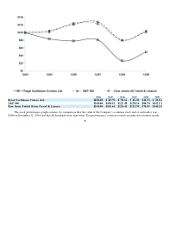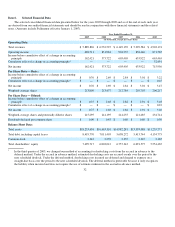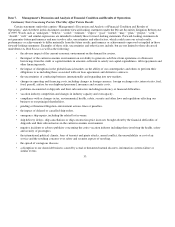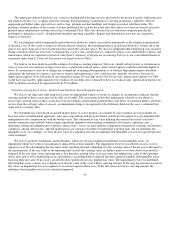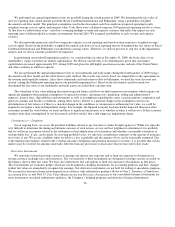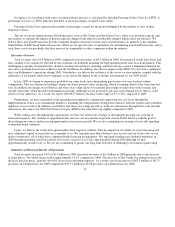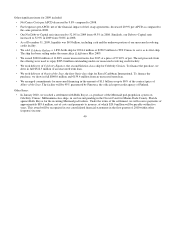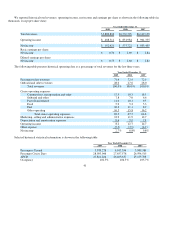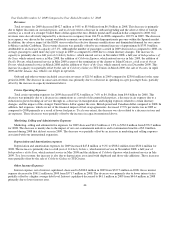Royal Caribbean Cruise Lines 2009 Annual Report Download - page 45
Download and view the complete annual report
Please find page 45 of the 2009 Royal Caribbean Cruise Lines annual report below. You can navigate through the pages in the report by either clicking on the pages listed below, or by using the keyword search tool below to find specific information within the annual report.
The significant deferred drydock costs consist of hauling and wharfage services provided by the drydock facility, hull inspection
and related activities (e.g. scraping, pressure cleaning, bottom painting), maintenance to steering propulsion, stabilizers, thruster
equipment and ballast tanks, port services such as tugs, pilotage and line handling, and freight associated with these items. We
perform a detailed analysis of the various activities performed for each drydock and only defer those costs that are directly related to
planned major maintenance activities necessary to maintain Class. The costs deferred are not otherwise routinely periodically
performed to maintain a vessel’s designed and intended operating capability. Repairs and maintenance activities are charged to
expense as incurred.
We use judgment when estimating the period between drydocks, which can result in adjustments to the estimated amortization
of drydock costs. If the vessel is disposed of before the next drydock, the remaining balance in deferred drydock is written-off to the
gain or loss upon disposal of vessel in the period in which the sale takes place. We also use judgment when identifying costs incurred
during a drydock which are necessary to maintain the vessel’s class certification as compared to those costs attributable to repairs and
maintenance which are expensed as incurred. (See Note 2. Summary of Significant Accounting Policies to our consolidated financial
statements under Item 8. Financial Statements and Supplementary Data).
We believe we have made reasonable estimates for ship accounting purposes. However, should certain factors or circumstances
cause us to revise our estimates of ship service lives or projected residual values, depreciation expense could be materially higher or
lower. If circumstances cause us to change our assumptions in making determinations as to whether ship improvements should be
capitalized, the amounts we expense each year as repairs and maintenance costs could increase, partially offset by a decrease in
depreciation expense. If we had reduced our estimated average 30-year ship service life by one year, depreciation expense for 2009
would have increased by approximately $22.2 million. If our ships were estimated to have no residual value, depreciation expense for
2009 would have increased by approximately $115.8 million.
Valuation of Long-Lived Assets, Goodwill and Indefinite-Lived Intangible Assets
We review our ships and other long-lived assets for impairment whenever events or changes in circumstances indicate that the
carrying amount of these assets may not be fully recoverable. The assessment of possible impairment is based on our ability to
recover the carrying value of these assets based on our estimate of their undiscounted future cash flows. If estimated future cash flows
are less than the carrying value of an asset, an impairment charge is recognized for the difference between the asset’s estimated fair
value and its carrying value.
We determine fair value based on quoted market prices in active markets, if available. If active markets are not available we
base fair value on independent appraisals, sales price negotiations and projected future cash flows discounted at a rate determined by
management to be commensurate with the business risk. The estimation of fair value utilizing discounted forecasted cash flows
includes numerous uncertainties which require significant judgment when making assumptions of revenues, operating costs,
marketing, selling and administrative expenses, interest rates, cruise vacation industry competition and general economic and business
conditions, among other factors. Quoted market prices are often not available for individual reporting units and for indefinite-life
intangible assets. Accordingly, we base the fair value of a reporting unit and an indefinite-life intangible asset on an expected present
value technique.
We review goodwill, trademarks and tradenames, which are our most significant indefinite-lived intangible assets, for
impairment whenever events or circumstances indicate but at least annually. The impairment review for goodwill consists of a two-
step process of first determining the fair value of the reporting unit and comparing it to the carrying value of the net assets allocated to
the reporting unit. If the fair value of the reporting unit exceeds the carrying value, no further analysis or write-down of goodwill is
required. If the fair value of the reporting unit is less than the carrying value of its net assets, the implied fair value of the reporting
unit is allocated to all its underlying assets and liabilities, including both recognized and unrecognized tangible and intangible assets,
based on their fair value. If necessary, goodwill is then written down to its implied fair value. The impairment review for indefinite-
life intangible assets consists of a comparison of the fair value of the asset with its carrying amount. If the carrying amount exceeds its
fair value, an impairment loss is recognized in an amount equal to that excess. If the fair value exceeds its carrying amount, the
indefinite-life intangible asset is not considered impaired.
35


